Kerala Plus One Botany Model Question Paper 1 with Answers
| Board | SCERT |
| Class | Plus One |
| Subject | Botany |
| Category | Plus One Previous Year Question Papers |
Time: 1 Hour
Cool off time: 10 Minutes
Maximum Marks: 30
General Instructions to candidates
- There is a ‘cool off-time’ of 10 minutes each for Botany and Zoology in addition to the writing time of 1 hour each. Further, there is a ‘5 minutes’ ‘preparatory time’ at the end of the Botany Examination and before the commencement of the Zoology Examination.
- Use the ‘cool off time’ to get familiar with the questions and to plan your answers.
- Read the instructions carefully.
- Read questions carefully before you answering.
- Calculations, figures and graphs should be shown in the answer sheet itself.
- Malayalam version of the questions is also provided.
- Give equations wherever necessary.
- Electronic devices except non-programmable calculators are not allowed in the Examination Hall.
I. Qn. No. 1 to 3. Answer all questions. Each question carries 1 score. (3 × 1 = 3)
Question 1.
Choose the correctly matched pair.
a) Telocentric chromosome – Middle centromere
b) Metacentric chromosome – Centromere slightly away from the middle
c) Acrocentric chromosome – Centromere close to its end
Answer:
c) Acrocentric chromosome – centromere close to end
Question 2.
Choose the correct answer.
Law of limiting factors is proposed by
a) Cornelius Van Niel
b) Blackman
c) Joseph Priestley
d) Engelmann
Answer:
b) Blackman
Question 3.
Observe the figure given below and identify the blue green alga.
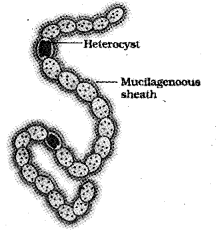
Answer:
Nostoc
II. Qn. No. 4 to 11. Answer any 6 questions. Each question carries 2 scores. (6 × 2 = 12)
Question 4.
Certain compounds formed during Kreb’s cycle are given below. Draw Kreb’s cycle using the compounds.
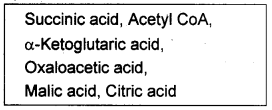
Answer:
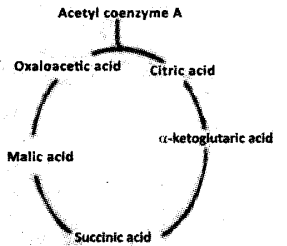
Question 5.
Water from the root hairs move deeper into the root layers by two pathways. Name the two pathways. Which pathway is blocked in the endodermis? Give reason.
Answer:
Apoplast and symplast pathways.
Apoplast pathway is blocked. It due to the presence of suberised material on endodermis (Casparian strips)
Question 6.
Analyse the table and fill in the blanks.

Answer:
a) Golgi apparatus
b) Basal body of cilia/flagella/spindle fibers
c) Protein synthesis
d) Mitochondria
Question 7.
Artificial system and natural system are two systems of classification. Who are the proponents of these two systems? Write the criteria used by them for these classifications.
Answer:
- Artificial system – Carl Linnaeus
- Natural system – George Bentham and Joseph Hooker
- Artificial system – it is based on external characters
- Natural system – it is based on both external and internal characters
Question 8.
Name of certain essential elements are given below:
Potassium, Manganese, Molybdenum, Copper, Magnesium
Choose the macronutrients and write one function of each of them.
Answer:
Potassium, Magnesium.
Potassium:
- It maintains anion cation balance
- It is involved opening and closing of stomata
Magnesium:
- It maintains ribosome structure
- It is an important constituent of chlorophyll
Question 9.
Pili and fimbriae are surface structures seen in bacterial cells. Differentiate these structures.
Answer:
- Pili are elongated tubular structures helps in conjugation
- Fimbriae are small bristle like structures helps to attach host tissues
Question 10.
Carbohydrates and fats are respiratory substrates. But there RQ is different. Define RQ. Write the RQ of these substrates.
Answer:
RQ – It is the ratio of volume of CO2 evolved to volume of oxygen consumed.
RQ of carbohydrate is 1
RQ of fats is 0.7
Question 11.
Certain lifecycle patterns of various plant groups are given below:
Diplontic, Haplontic, Haplo-diplontic
Choose the life cycle pattern shown by gymnosperms and angiosperms. Write the peculiarities of the identified life cycle pattern.
Answer:
Diplontic.
- Here diploid sporophytic phase is dominant phase in life cycle of gymnosperm
- It is independent and free living that produce spores
III. Qn. No. 12 to 17. Answer any 5 questions. Each question carries 3 scores. (5 × 3 = 15)
Question 12.
Observe the figure given below:

a) Source of which plant hormone is indicated in the figure.
b) Write four roles of the above identified hormone.
Answer:
a) Auxin
b) 1. It initiate rooting in stem cuttings
2. It induce pathenocarpy
3. It control xylem differenciation
4. It cause apical dominance
Question 13.
Observe the terms given below:
Vexillary, Axile, Marginal, Imbricate, Basal, Valvate.
Identify the three kinds of placentation from the above. Explain them.
Answer:
Axile, marginal, basal.
- Axile – The placenta is axial and ovules are attached to it.
- Marginal – Ovules are arraged on margines of single chambered carpel
- Basal – In this placenta at base of ovary and single ovule is arranged
Question 14.
Observe the figure
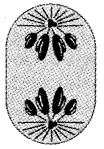
a) Identify the above stage of mitosis.
b) Name the preceding stage of the above stage. Write its main events.
Answer:
a) Anaphase
b) Metaphase
The chromosomes are highly condensed and they are arranged at equatorial plane
Question 15.
Observe the flow chart given below:
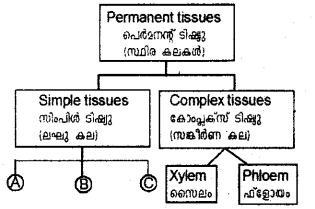
a) Identify A, B, C. Write the function of B.
b) Diffemtiate endarch and exarch xylem.
Answer:
a) Parenchyma, collenchyma, sclerenchyma
Function – It gives mechanical support
b) Endarch- The protoxylem facing towards centre and metaxylem towards periphry
Exarch – The protoxylem facing towards periphery and metaxylem towards centre
Question 16.
Observe the diagrammatic representation of Hatch and Slack pathway given below:
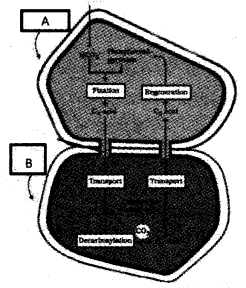
Identify the cells A and B. Explain the process of C4 acid specifying the enzyme involved.
Answer:
A – mesophyll cell
B – bundle sheath cell
PEP absorbs CO2 and form C4 acid OAA acid in presence of PEP Carboxylase.
Question 17.
Periderm is constituted by three kinds of tissues. Name them. Write one peculiarity of each of them.
Answer:
It consist of three types of tissues
Phellum, phellogen, phelloderm
- Phellooen – Cork cambium
- Phellum – It is dead tissue found outer to cork cambium which is impervious to water
- Phelloderm – It is the living tissue found towards inner side of cork cambium.
